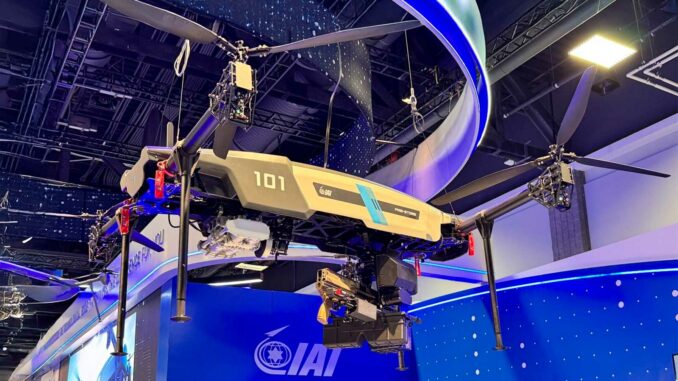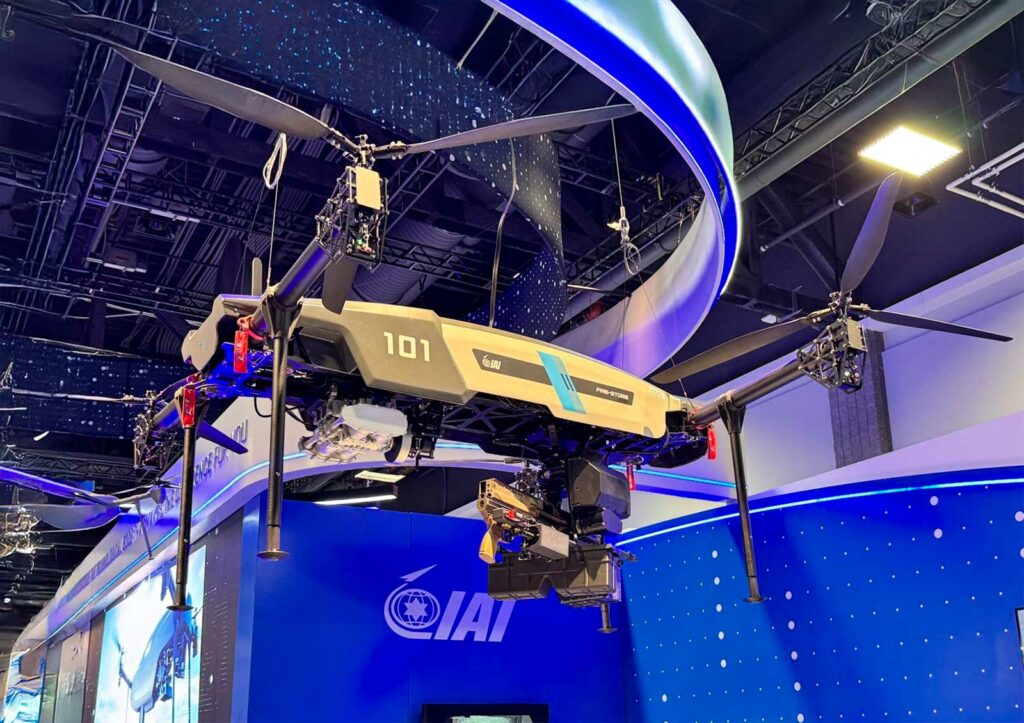
IAI presents the Fire Storm 250, a quadcopter drone armed with a machine gun, to support tactical units with precision and endurance in close combat.
Summary
At the 2025 edition of AUSA in Washington, Israel Aerospace Industries (IAI) officially unveiled the Fire Storm 250, a four-engine drone armed with a robotic machine gun, developed in collaboration with Sig Sauer. This aircraft combines vertical hovering, extended endurance (up to 3 hours), and fire support capability for tactical units. It carries up to 200 rounds, uses a stabilized platform and control algorithms to maintain firing accuracy while moving or hovering. Designed for short-range engagements, it targets urban areas or difficult terrain without the need for heavy launch infrastructure. In terms of competition, it is part of the trend toward light armed drones (loitering, gun drones), but innovates with its direct fire capability and tactical modularity. The stakes are high: legal risks, AI-assisted targeting, proliferation of lethal drones, and scenarios of use (special forces, perimeter security, ambushes). The Fire Storm 250 could be deployed in theaters where conventional forces lack air cover or for local saturation against light groups.
Introducing the Fire Storm 250: features and ambitions
Who is behind the project?
The Fire Storm 250 is the result of a partnership between IAI (Israel Aerospace Industries) and Sig Sauer, a well-known firearms manufacturer. This collaboration combines expertise in aerial systems with precision weaponry. IAI describes its drone as a “high-performance tactical quadcopter equipped with a robotic machine gun, designed for rapid deployment, precision lethality, and sustained mission endurance.” (sic)
According to the technical specifications, the drone can fly for up to three hours continuously while carrying 200 rounds of ammunition. The platform incorporates a stabilized firing platform and advanced control algorithms to maintain aim even while moving or hovering.
The quadcopter format allows for vertical takeoff and landing (VTOL) without infrastructure, making it suitable for restricted, urban, or uneven terrain areas.
IAI claims that the Fire Storm 250 is a “mission-ready” solution combining reconnaissance and precision strike in a single aircraft. However, it is interesting to note that the description of the system was removed from IAI’s official website after the unveiling, without any public explanation.
Functionality, armament, and tactical range
The onboard machine gun is designed for robotic use, controlled by the operator via an encrypted link. The device must compensate for recoil and stabilize the shot to ensure accuracy comparable to a fixed platform.
The drone carries 200 rounds—which limits the number of bursts or possible targets in a mission. Its modest size (quadcopter) makes it suitable for light strikes, not as a replacement for missiles or heavy ammunition.
The operational range is not specified precisely beyond the autonomy, but the system is intended for short-range engagements, integrated with ground units to support rapid maneuvers or secure hostile areas.
Intended uses and tactical doctrines
Tactical support for small units
The Fire Storm 250 falls into the category of tactical gun drones—lightly armed drones capable of providing immediate fire support to squads. It can reinforce cover in narrow passages, slow down an assault, neutralize a light position, or monitor an area while maintaining offensive capability without waiting for a helicopter or aircraft.
Its advantage is responsiveness: deployed quickly, it can attack in a matter of minutes, without relying on a runway or heavy air ramp-up.
Likely scenarios of use
- Urban areas: close combat zones, where a weaponized drone can engage hidden enemies or snipers.
- Perimeter protection: isolated base or threatened outpost, a Fire Storm 250 monitors and responds to light incursions.
- Attacks against light mobile groups: ambushes, reconnaissance, and then precision fire without exposing human assets.
- Saturation: in a context of drone density, several Fire Storm 250s could saturate light defenses to create strike windows.
Operational limitations and constraints
- The 3-hour endurance imposes limited range constraints.
- The limited ammunition supply of 200 rounds requires sparing use.
- Recoil and stabilization are major technical challenges when firing from a moving or stationary vehicle.
- The communication link must be secure and resilient to jamming or interference.
- Vulnerability to anti-drone defenses or electronic warfare systems is high, due to the lack of heavy decoys or armor.
- Deploying an armed drone carries ethical, legal, and escalation risks, particularly if it can be automatically directed at human targets via AI.
Competition, risks, and AI integration
Competitors and market trends
Other light weapon systems or loitering munitions drones are already on the market. However, few integrate an automatic cannon or machine gun onto an autonomous drone.
Some academic and military projects are exploring hybrid gun drones, but often in experimental mode.
The Fire Storm 250 stands out by combining reconnaissance and direct fire capability in a compact format.
Risks associated with the integration of AI and autonomy
While the human operator controls the firing, the integration of AI can assist with target selection, firing optimization, stabilization, and even target classification. This partial autonomy raises ethical (determination of human targets) and legal (liability) questions.
The proliferation of lethal drones equipped with AI capabilities creates a drone vs. drone dynamic: jamming, interference, and spectrum conflicts.
The risks of false positives, targeting errors, or control link hacking are significant. A poorly controlled armed drone can become a danger to civilians or friendly forces.

Deployment and acceptance on the battlefield
Likely theaters of use
The Fire Storm 250 could initially be deployed in areas of asymmetric conflict: the Middle East, Africa, missions against insurgent groups.
Special fleets, special operations forces, or light units could be the first users, in contexts where air superiority is not complete or where heavy assets cannot be deployed quickly.
Urban or mountainous environments where helicopters are vulnerable are particularly suited to this type of armed drone.
Strategic acceptance and restrictions
Customer armies will need to assess the political, legal, and reputational impact. The use of armed drones is already controversial.
Some states will impose restrictions on the use of automatic weapons mounted on drones because of the risks to civilian populations or to restrict remote assassinations.
Interconnection with chains of command
The Fire Storm 250 will most likely be integrated into an existing command and control (C2) network, coupled with ISR, targeting systems, ground stations, and larger reconnaissance drones. It will play a role in the local tactical kill chain: spot, classify, shoot.
The data from this drone could enrich ground sensors, serve as links in a network of interconnected drones, or coordinate multi-domain strikes.
This unveiling of the Fire Storm 250 by IAI marks a turning point: automatic weaponry carried on a light drone, not only as kamikaze ammunition, but as a controlled firing platform. The concept of the tactical gun drone is taking operational shape. The challenge will be to master the technical aspects (stabilization, ammunition, link security), the ethical implications, and resilience to countermeasures. Its success will depend on acceptance by the armed forces, doctrines of use, adversarial responses, and future international legislation.
War Wings Daily is an independant magazine.